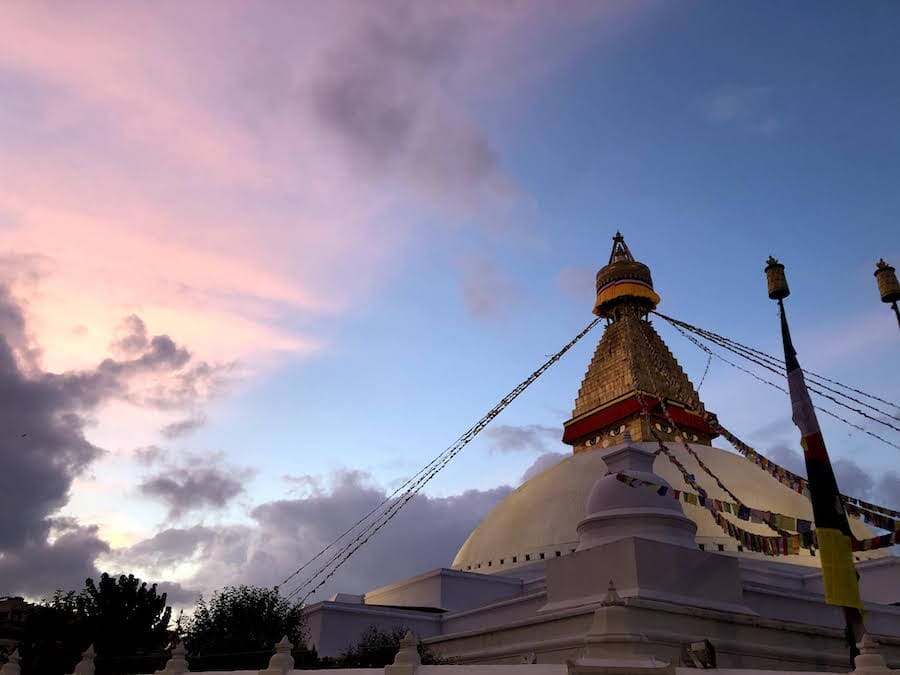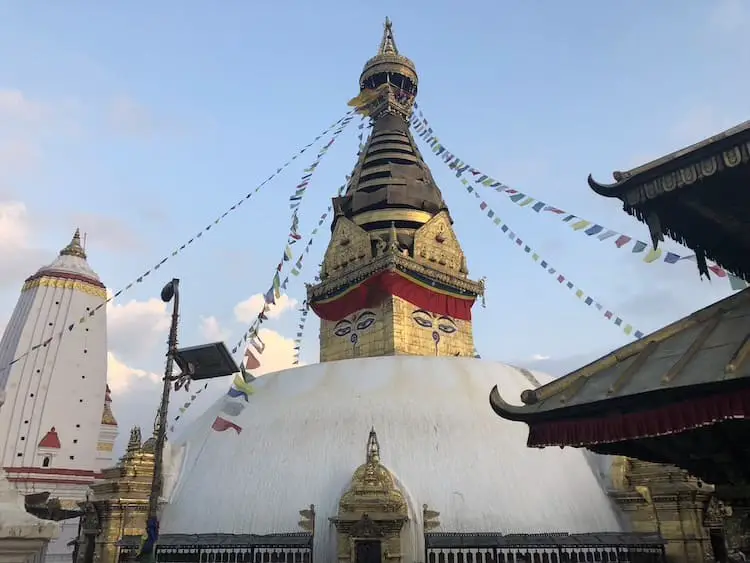Nepal is rich in heritage and culture, with temples, shrines, and monasteries doting the country. From the Terai in the south to the Himalayas in the north, you can find a temple around every corner. Take, for example, Kathmandu, which is rightfully known as the ‘City of Temples’. Many of the local’s joke that you can’t travel more than 100 meters without passing a temple or shrine! With so many important temples throughout the country, how will you ever know which ones are the most famous temples in Nepal?
As a tourist, you may not understand all the intricacies of religion in Nepal, especially Hinduism and Buddhism. However, I know that is not going to stop you from wanting to visit some of the most awe-inspiring temples in South Asia. With temples dating back centuries, the architecture and design of these temples open a window to the past. Built out of stone, metal, brick, and wood, the temples scattered across the country are a testament to the creativeness of Nepalis. Moreover, these temples are the location of some of the most important festivals in Nepal.
This article will look at 9 of the most famous temples in Nepal, and discuss their importance and history. The 9 temples that are the most well-known in Nepal are:
1. Pashupatinath Temple – Famous Temples in Nepal:
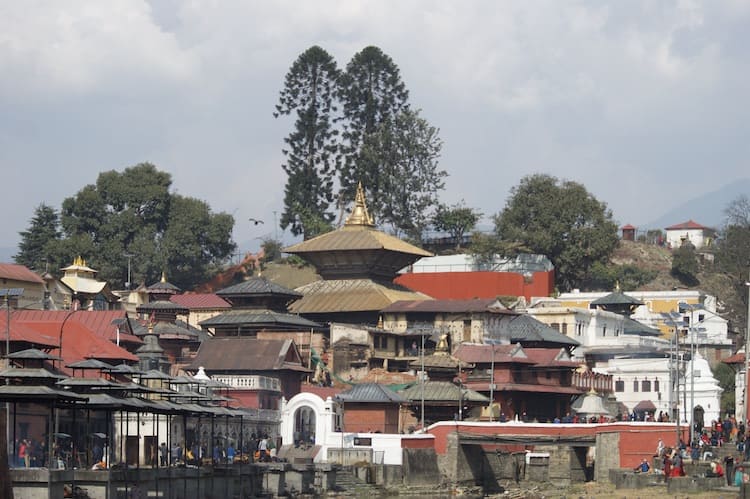
The Pashupatinath Temple (in Nepali: श्री पशुपतिनाथ मन्दिर) is a Hindu temple dedicated to Pashupati and is located in Kathmandu, Nepal. Pashupati is a Hindu deity and an incarnation of the Hindu god Shiva as the “lord of the animals”. Moreover, the Hindu deity Pashupati is mainly worshiped in Nepal and India and is the national deity of Nepal.
Pashupatinath temple’s exact construction date is unknown but the current form was constructed in 1692 CE. The current form is also an intricate and extensive collection of ever sprawling temples, ashrams, images, and inscriptions that have been erected over the centuries. Additionally, the extensive Hindu temple precinct that encompasses the area was classified as a UNESCO World Heritage Site in 1979, making it one of the seven monument groups in UNESCO’s designation of the Kathmandu Valley.
Pashupatinath temple, one of the most famous temples in Nepal, resides along the sacred Bagmati river, in Kathmandu. Although the main temple is closed off to non-Hindus, visitors and tourists alike can venture around the premises and take in the rest of the temples in the area. To enter the premises, a ticket is needed which costs NPR 1,000.
The main attraction that attracts a significant number of both locals and tourists, is the Aarati. The Aarati, or the daily ritual worship and offering of prayers by the priests at the temple, draws in a crowd every night. Whereas the evening rituals are by far the most popular and are performed by priests and accompanied by a band singing hymns in praise of God, music being played on classical instruments, the chanting of Vedic mantras, ringing of bells, burning of incense, and the lighting of oil lamps.
2. Mayadevi Temple:
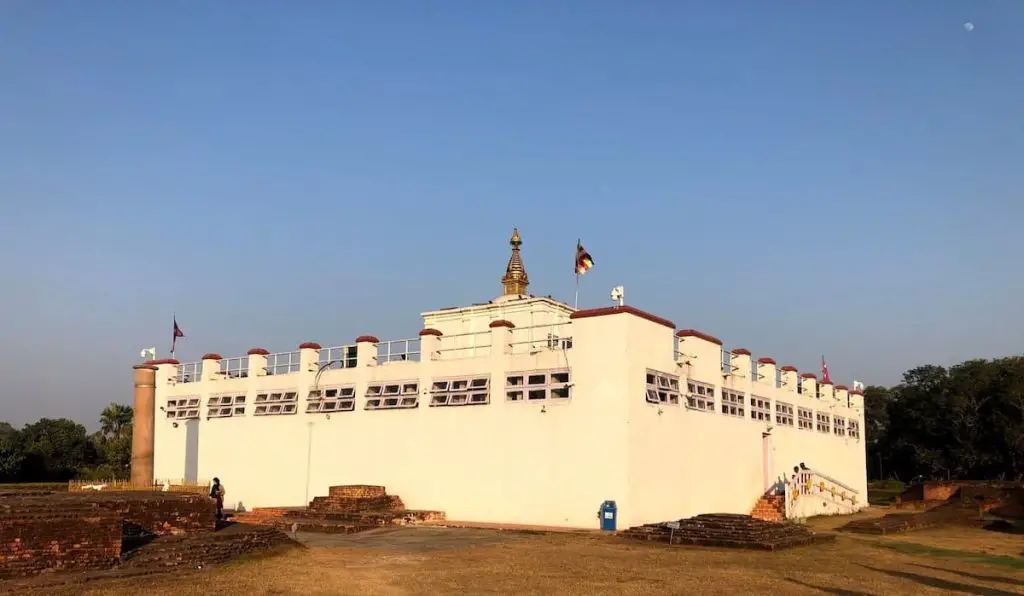
The Mayadevi Temple is at the heart of Lumbini in Rupandehi and is the main attraction in the Sacred Garden and the overall Lumbini Development Trust compound. Mayadevi Temple, named after Lord Sakyamuni Buddha’s mother, is where she gave birth to the Buddha over 2,500 years ago! The temple, which is one of the most famous temples in Nepal, welcomes tens of thousands of visitors each year, who enter the grounds to see the birth spot of the Buddha.
Buddha’s birth spot is marked by the marker stone which is visible to all religious visitors and tourists alike. Additionally, the temple houses the Nativity Sculpture and the structural ruins of past Mayadevi Temples which date back to as early as the Asoka period. Whereas, when Emperor Ashoka visited Lumbini in 249 century BC, he built a platform using burnt bricks to safeguard the Marker Stone and the Nativity Tree under which Mayadevi gave birth to Prince Siddhartha.
Over the centuries, various temples have been erected to protect and pay respect to the Buddha. Although an important aspect of Buddhist culture, the memory began to fade away, and it wasn’t until 1896 that the temple was rediscovered by General Khadga Shamsher and Dr. Anton Fuhrer. With reference to the Ashoka pillar, the two were able to confirm that the area was indeed the birthplace of Buddha, and in 1939 Keshar Shumsher excavated the mound of early Mayadevi Temple and reconstructed the famous temple. The present-day Mayadevi Temple was rebuilt in 2003 by Lumbini Development Trust.
The structural ruins inside Mayadevi Temple date back to the 6th century BC and all the way up to the 15th century AD. The ruins of the past temples consist of 5 rows running east to west and 3 rows running north to south, making up 15 total box chambers. Moreover, the inner structure was surrounded by an outer wall.
Finally, during a recent archaeological excavation from 2010 to 2013 AD, uncovered a timber shrine dating back to the 6th century BC. Furthermore, they unearthed a pre-Mauryan brick structure suggesting that the first Mayadevi Temple was built immediately after the Mahaparinirvana of Lord Sakyamuni Buddha in Lumbini.
3. Manakamana Temple

The Manakamana Temple is another auspicious and famous temple in Nepal which is located in Gorkha district, about 140 km west of Kathmandu. Perched on the hilltop about 1,300 meters above sea level, the historic temple can be reached by a 10-minute cable car ride. Or you can decide to hike to the top to see the Temple, which will take about four hours.
The temple is the sacred place of the Hindu Goddess Bhagwati, who is an incarnation of Parvati. One reason the temple is so famous is because of the belief that if a visitor makes a wish at the temple, it will be fulfilled. This belief can even be seen in the temple’s name: Manakamana, which can be broken down into two Nepali words. Whereas ‘Mana’ or ‘Maan’ means heart, and ‘Kamana’ means to wish. In order for your wish to be grated, you should pay your respect to the Goddess of the famous temple. One of the following should be provided amongst the offerings:
- Abiir (vermillion)
- Kesar badam (pure saffron and almond )
- Flowers and leaves
- Dhup (incense)
- Diyo (oil lamp)
- Bastra (Cloth, usually in red as it is considered auspicious)
- Fruit and foods such as coconuts and sweet desserts
- Bell
- Betel nut and jannai (sacred thread)
- Anna, grain (rice)
- saubhagya (red cloth, Chura, pota, etc.)
As for the famous temple, the beautiful architecture attracts Hindus and non-Hindus alike. The temple is constructed in a four-storied traditional Nepalese pagoda style and features an ambulatory (or covered walkway) around the outside of the temple. Moreover, the entire Manakamana temple ground spans over 7,659 ropani, or 3.8930 sq. km of land. The temple has been reconstructed a few times due to earthquakes and is currently made out of limestone, surkhi, bricks, and wood, and the roof, the door, the final, and windows are all gold-plated with 14 kilograms of gold.
Just remember, after visiting the temple, and making your wish, once it has been granted, you must return to Manakamana and display your gratitude to the Goddess Devi. However, make sure to note that if you are a non-Hindu, you won’t be able to enter the temple to worship the Devi, and will have to enjoy the temple and its greatness from the outside.
4. Muktinath – Famous Temples in Nepal
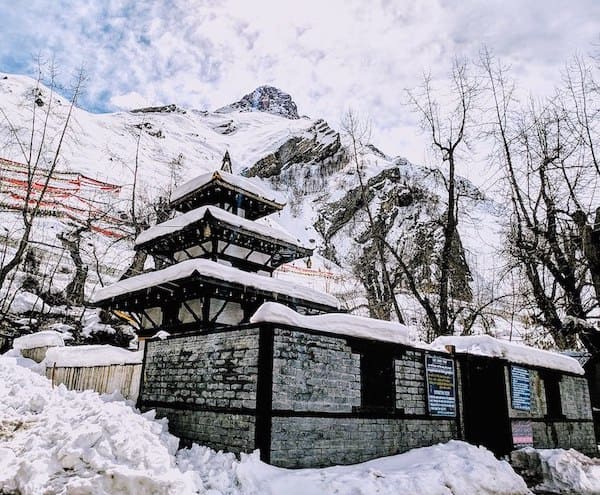
Nepal has plenty of famous temples, and Muktinath Temple is definitely one of them. Located in the Muktinath Valley at the foothills of the snow-covered Thorong La mountain pass in Mustang, Nepal. At an elevation of 3,710 meters above sea level, the pagoda-style temple is one of the world’s highest temples.
Muktinath is a temple for Vishnu and is sacred among both Hindus and Buddhists. Moreover, it is one of the 24 tantric places on earth, according to Tibetan Buddhist culture, the temple is regarded as one of the most sacred areas in Nepal. Additionally, due to its significance, the temple is famous for having extreme importance for ‘Dakinis’ or the goddesses known as Sky Dancers.
Muktinath temple is also home to one of the holiest shrines, known as Svayam Vyakta Kshetras, and houses an idol made from gold. Puja, or worship in English, is paid to the Vishnu idol who has been reincarnated as Shri Mukti Narayana, which stands as tall as a human. Moreover, the puja is conducted in the presence of a Buddhist monk and with pilgrims paying their respects by making a religious offering to the deity. Additionally, with the Buddhist monks present, and the heavily ingrained Tibetan culture in the area, the Muktinath temple area is a great place to learn about the ancient traditions and culture of Tibet and Nepal.
Finally, the temple is famous for its 108 bull head-shaped stone faucets in the rear of the temple. These bullheads are situated at a height of seven feet and approximately one foot apart. These heads serve as water spouts where the frigid ice water is diverted from the Kali Gandaki River below allowing for pilgrims and devotees to cleanse and rise themselves beneath them.
5. Swayambhunath
Swayambhunath, commonly known as Monkey Temple amongst tourists, is not only famous for Nepal, but also for Buddhism in general. One of the top two famous Buddhist temples in Kathmandu – the other being Boudhanath – is an ancient religious complex that is adorned with the main stupa as well as smaller shrines, temples, stupas, and even a Buddhist monastery.
The famous stupa is believed to be built in the Lichchavi period and was founded by the great-grandfather of King Mānadeva (464-505 CE), King Vṛsadeva, about the beginning of the 5th century CE. Moreover, the current Swayambhunath premises is a collection of additions and renovations over the centuries, with the most recent renovations taking place in May 2010. Which was the first major renovation in almost 100 years.
The architecture of the main stupa consists of a large white dome – which represents the entire world – with a cubical structure sitting on top of it. The cubical structure has the famous Buddha face painted on all four sides – representing that when a person finally awakes and is able to reach enlightenment, they will finally have their eyes open. This representation of enlightenment embodied in the famous stupa is further carried forward with the thirteen pinnacles resting on top of the cubical structure. This represents that we have to go through thirteen stages of spiritual realizations to be able to reach enlightenment.
6. Boudha
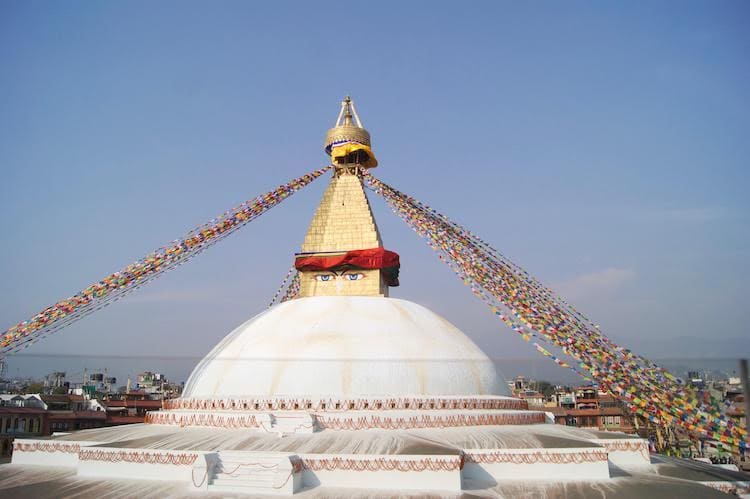
Boudhanath is one of the most revered Buddhist temples in Nepal as well as Asia. As it is one of the biggest stupas in the region, it stands at an impressive 36 meters and is in the shape of a mandala. Buddhist devotees come to visit the masterpiece and pay their respects in the form of prayers, as well as by circumnavigating it.
Standing in the middle of a chaotic Kathmandu, the stupa sits on an ancient trade route between Tibet and India. Moreover, the stupa has been a significant religious attraction for centuries as it was built in 600 AD time period. It has also gone through renovations, with one occurring in the 8th century by the Lichchavi rulers. Furthermore, the stupa was significantly damaged in the 2015 earthquake in Nepal, resulting in the entire top half of it needing to be rebuilt.
The white-washed dome of the stupa and its surrounding areas have been home to Tibetan merchants since the area was important for trade purposes. Moreover, a lot of Tibetan refugees have also settled in the area. Therefore, when one visits the temple, they will be welcomed by a mix of Nepali and Tibetan cultures all tied together by Buddhism. It is one of the most peaceful areas in Kathmandu Valley, and one can enjoy the monasteries in the area, as well as some delicious Tibetan food, like butter tea, laphing, and shapaley. If you are interested in finding out more about the delicious street food around the Boudha area, have a look at our best street foeetod in Kathmandu blog!
7. Changu Narayan Temple – Famous Temple in Nepal
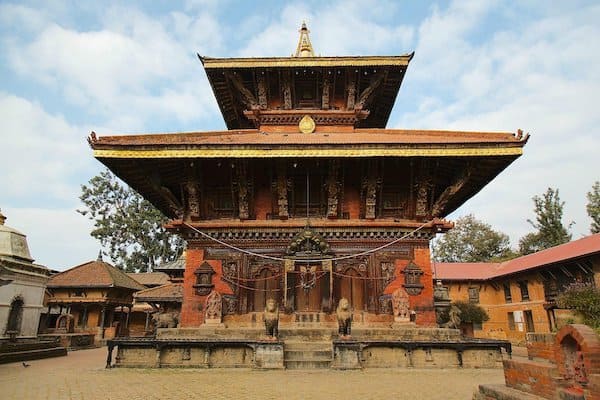
Not only is this temple famous but it is also the oldest temple in Nepal. With carvings dating back more than 1,500 years. Whereas, on the western entrance gate, you can find Sanskrit inscriptions that were erected during the Lichchavi kingdom, by King Manadeva in 464 AD, which is considered to be the oldest inscriptions in all of Nepal.
The Changu Narayan Temple is famous for its vast history, collection of sculptures, carvings, and metal work, as well as its unique architecture. With nods to the pagoda style of architecture, the temple is said to be slightly different and has been coined as a traditional Nepali temple. The temple has a vast number of sculptures surrounding it that pay tribute to Lord Vishnu, as well as other gods like Lord Shiva, Ashta Matrika, Chhinnamasta, Kileshwor, and Krishna.
Changu Narayan Temple in Bhaktapur has four entrances to it with large gates that are guarded by giant stone carvings of animals such as lions, sarabhas, griffins, and elephants, who are all considered guardians in Hindu culture. Finally, possibly the most famous aspect of the temple is the Narasingha (half lion and half man) statue.
If you find yourself visiting the temple, make sure to check out one of the many museums in the area, to find out more about the historical past and culture of the area. A couple of the museums you can visit are the Changu Museum – which has a collection of ancient coins, tools, arts, and architecture. Additionally, the museum has a vast collection of ancient, historical, artistic, religious, archaeological, and cultural rare artifacts. The other museum you can visit is the ethnographic museum – which displays the artistic and cultural traditions of the various cultural groups within the four primary regions of Nepal.
8. Budhanilkantha Temple:
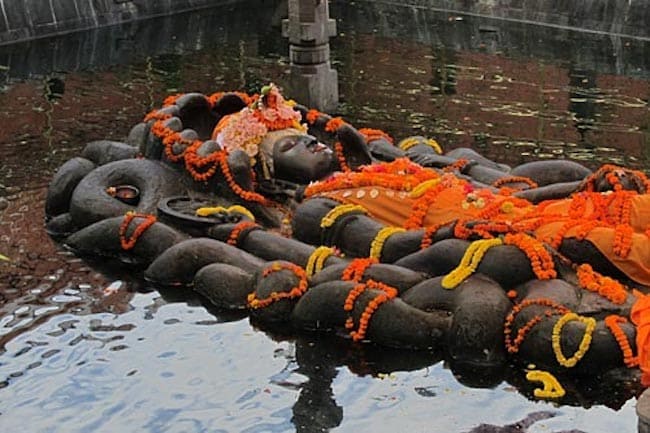
The Budhanilkantha is not only a famous temple in Nepal but in all of South Asia. This is because it has the largest stone sculpture of Lord Vishnu, sleeping on a bed of serpents. Lord Vishnu is one of the significant deities in Hindu culture and is part of the triple deity of supreme divinity. The 5-meter-long Lord Vishnu statue sleeps in the middle of a small man-made lake, which represents the cosmic sea. Moreover, the sleeping Vishnu has been revered by Hindus for centuries. Whereas the carving, made out of a single block of basalt stone, dates back to the 5th century.
The temple’s compound is situated below Shivapuri hills and has an array of other small temples and shrines. The auspicious area is visited by hundreds of devotees every day to pay their respects to the famous Sleeping Vishnu. Vishnu holds the Sudarshana Chakra, a Club, a Conch Shell, and a gem in his four hands. Moreover, the statue is well adorned with a crown engraved with multiple Kirtimukha images which can often be seen being overlapped by a silver crown.
Legend has it that the Nepali monarchs were forbidden to set eyes on the sleeping Vishnu due to a prophetic vision that King Pratap Malla had in the 17th century. Whereas, the kings of Nepal were considered to be the reincarnation of Lord Vishnu, and thus, could never set eyes on the sleeping deity in Budhanilkantha. However, it is rumored that Prince Dipendra, once visited the sleeping Vishnu statue, and may have fulfilled the prophecy for the Royal Family Massacre of Nepal.
9. Bindabasini Temple:
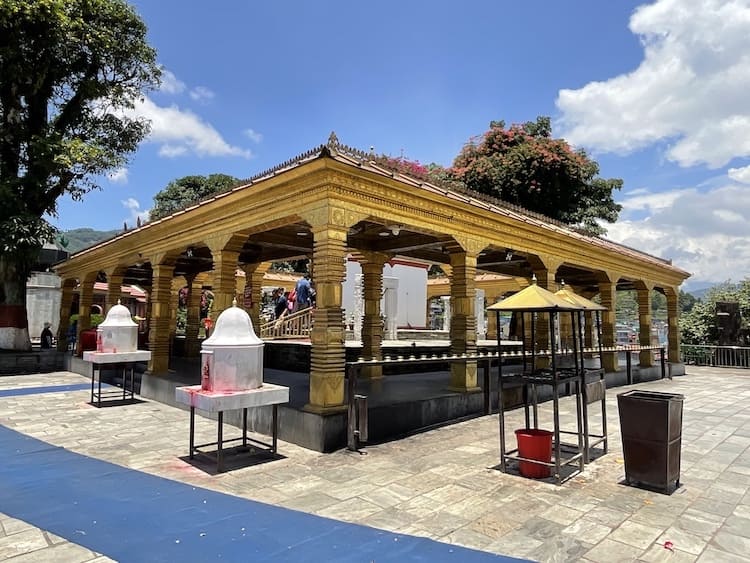
The Bindabasini Temple (Nepali: बिन्ध्यबासिनी मन्दिर) is the oldest temple in Pokhara. Visited by a large number of local and foreign tourists, it is a famous temple in Nepal. Bindhyabasini is devoted to the goddess Bindhyabasini, who is the incarnation of the god Kali. Around the temple, there are also various smaller temples and shrines dedicated to other goddesses and gods like Saraswati, Shiva, Hanuman, and Ganesh.
As legend has it, the temple was built by happenstance. The king of Kaski, Siddhi Narayan Shah, in a dream, was instructed to build a temple for the goddess Bindhyabasini. When he sent his servants to bring a statue from India of the goddess, they placed the statue down in the current location of the temple and rested for the night. The following morning, they were unable to lift the statue. After informing the King, he informed them to construct the temple where the statue sat.
True or not, the story of the beginning of the temple is a famous legend in the area. The temple was first built around 1760. However, the temple has foregone multiple reconstructions and the original design is unknown. The current temple is built in the Shikhara style; considered to be older than the famous pagoda architecture which is prevalent in Nepal.
The temple gates are guarded by two golden lions, which protect the deity inside. The outside of the temple is covered with copper plating and allows for pilgrims to circumnavigate. Finally, the temple stands at about 3,000 feet above sea level, but the entire compound comprises a much larger area. There is a park at the base of the stairs leading up to the main complex which has a seating area with ample shade as well as a large Shiva Linga and fountain.
